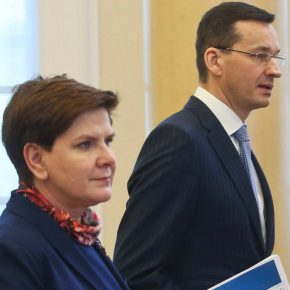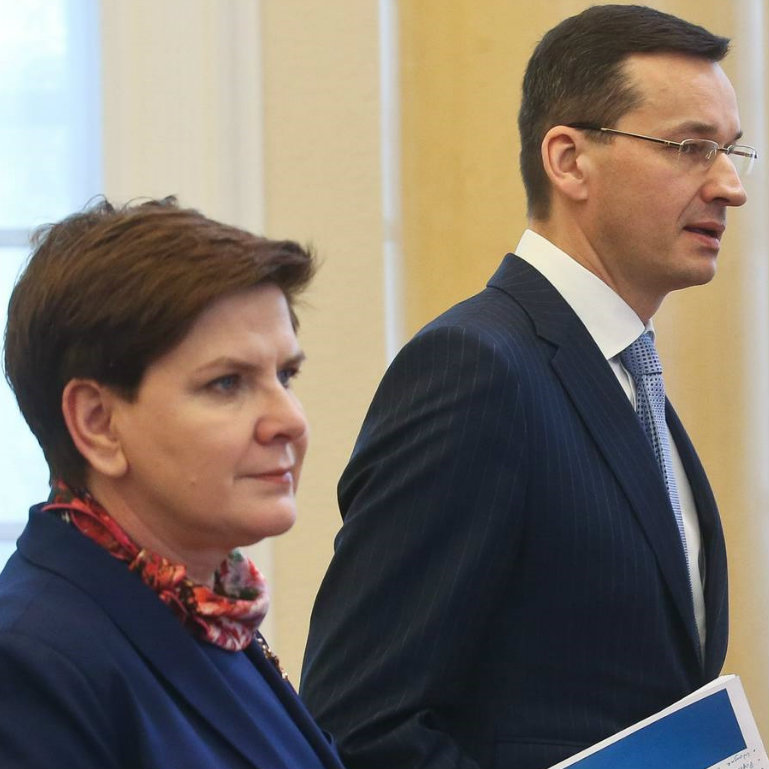Tydzień w gospodarce
Category: Raporty

Polish PM Beata Szydło and Deputy PM Mateusz Morawiecki (©PAP)
The “Morawiecki plan” projects about PLN1 trillion in investments in the period and plan aims “to strengthen Polish capital and the growth of innovativeness of Polish companies to be competitive on foreign markets,” a gradual development over the next quarter of a century.
Investments will reach PLN1 trillion by 2040. The ministry estimates that almost half of the funds, PLN 480 billion, will be from EU funds. “We want to prepare 20 large projects in infrastructure and industry which would be easy to commercialize,” Morawiecki said.
A key element of the plan is to improve Polish competitiveness internationally. The government will support innovation around the country, the minister said. An important point of the plan is to increase Poland’s participation in the digital revolution.
“We missed the first revolution – steam engines – because Poland was partitioned back then at the end of the eighteenth century. The second revolution – electricity – we also missed because we were fighting for independence. The third, the information revolution, also bypassed us, because [Poland] was then communist and under communist rule. Today, we are experiencing the fourth industrial revolution, often referred to as the digital one. We want to be in the eye of the storm of the digital revolution,” Morawiecki said.
The plan also emphasizes increasing jobs. “In order for Polish companies to create more and more jobs, we need to strengthen Polish exports, more precisely, to increase the value of companies creating jobs,” Morawiecki said, explaining that this would cause them to be able to pay better.
The new government has been aiming to reassure investors worried about the country’s spending plans. Since winning last September’s election, the Law and Justice government has seen the country’s main stock exchange index fall 17.5 per cent and the price of its 10-year debt rising.
“It is unfair and unfounded. We will be very friendly towards business,” Morawiecki, a former Santander executive, told the Financial Times. “This party has been associated sometimes with a less liberal approach . . . But the change should not unsettle investors. We are a market-oriented government that believes in a free economy.”
Morawiecki said Poland will consider a “diverted profits tax” to stop companies avoiding levies by routing profits overseas. Changes to the tax code would remove rules that reward companies for importing overseas technology and encourage research spending, which, at 0.8 per cent of GDP is among the lowest in the EU.
The PiS government won elections in 2015 by basing a significant part of its popular support on social discontent. It made a number of promises aimed at the poorest members of society, many of whom have been losers in the post-89 transformation and PiS’s natural constituency. Of these promises only the “PLN500 for a second child” has just been signed by the Polish President Andrzej Duda. The rest (lowering the pension age, increasing the tax-free (basic) income level, increasing the minimal wage, free medicines for over 75 year olds), have been shifted back due to lack of funds in the state budget. Any rapid introduction of these above reforms would translate into destabilization of state finances. Most likely most of them will now only be implemented with significant delays. In the medium-term period PiS therefore could risk significant social discontent and will have to implement some of its social oriented reforms before the next elections in 2019.
The PiS government is focused finding additional public funding. International sentiment over PiS will cost the state extra money, i.e. S&P’s rating cut will cost ca. 500 million euros. Thus, despite the social program being left to one side, the government will still have to look for additional sources of funding. Subsequently, entrepreneurs will face a significant increase in new taxes. For example, a commerce tax (instead of “market tax”), the bank tax, or sales tax (instead of increasing VAT). The “PLN500+ for the second child and subsequent” is expected to increase private spending and activate economic turnover.
We also wrote about the plan here.



